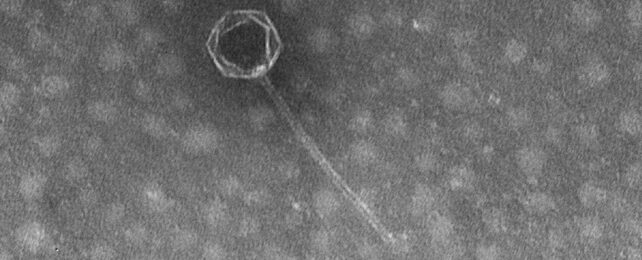Within the deepest, darkest, and most mysterious place on Earth lie miniscule parasitic monsters. Monstrous to microbes, at least.
Researchers have isolated a new type of virus that infects deep-sea Halomonas bacteria. This is the same group of microorganisms that are eating away at the wreck of the Titanic, but the host species in question lives in the extreme cold, highly pressured, and nutrient poor conditions in the deepest trenches of the ocean – the hadal zone.
"To our best knowledge, this is the deepest known isolated phage in the global ocean," says Ocean University of China marine virologist Min Wang.

Ocean University of China researcher Yue Su and colleagues retrieved the phage virus, vB_HmeY_H4907 inside its bacteria host, from sediment within the Mariana Trench, 8,900 meters (29,200 feet) deep.
Transmission electron microscopy revealed the virus protein has a 65 nm-wide, typical icosahedron shaped head. Its tail, which it uses to identify and penetrate its target bacteria, spans about 183 nm.
A study of the virus's genes failed to find a match for anything on record, suggesting it belongs to a completely new family of viruses. The researchers have called this viral family Suviridae.
Yet the phage's genetic code is similar to six other viral genomes found in the Halomonas bacteria, so the team believe Suviridae are a highly abundant and widely distributed group of phages.
These findings add to the enormous diversity of viruses thought to exist in this extreme environment, but vB_HmeY_H4907 is only the third strain isolated from a trench.
"Wherever there's life, you can bet there are regulators at work," explains Wang. "Viruses, in this case."
This role of regulators means that despite their tiny sizes and their inability to exist without their hosts, viruses such as these play a huge role in marine ecosystems, from top to bottom. They kill about 20 percent of our ocean's microbial biomass each day, releasing vast amounts of organic matter rich in nitrogen, phosphorus and carbon, which then provides food for the other microbes nearby. This process is called the viral shunt, and also acts to aggregate other debris to form marine snow – the viral shuttle.
Through these processes viruses help influence the ocean's biological carbon pump, which in turn impacts climate and so regulate Earth's ecology. Even down to the level of viruses all biological entities are connected.
But very little is known yet about how much the hadal zone communities contribute to these processes that are vital for all life on Earth. Su and colleague's findings provide a base from which researchers can now learn more about the life strategies and ecology of the viruses in these extremely harsh environments.
"Extreme environments offer optimal prospects for unearthing novel viruses," concludes Wang.
This research was published in Microbiology Spectrum.
